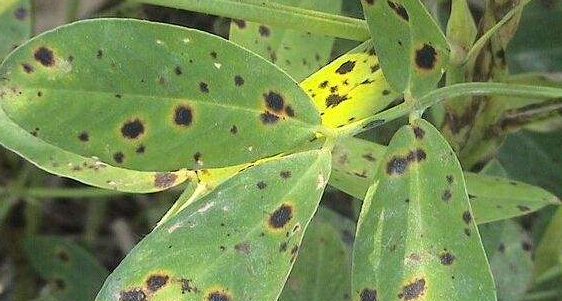Symptoms and control techniques of peanut leaf spot
Peanut leaf spot is a general term for peanut black spot, brown spot, net spot, and focal spot disease. It is an important disease on peanuts and has a great impact on the yield and quality of peanuts.
First, the symptoms of peanut leaf spot are mainly black spot and brown spot disease. Compared with brown spot disease, black spot disease has a wide range of epidemics and serious harm. Both diseases are dominated by harmful leaves. When peanuts develop, symptoms begin to appear from the lower leaves, and then gradually spread to the upper leaves. In the early stage of the disease, brown spots are produced, which gradually develop into round or irregular lesions. The brown spot disease has a large lesion, and there is a yellow halo around the lesion, while the black spot disease has a small lesion, the color is smaller than the brown spot disease, the edge is neat, and there is no obvious halo. The weather is wet or long-term rainy, the lesions can be combined into irregular large spots, and the leaves are scorched, which seriously affects photosynthesis. If it occurs on the petiole, stem or fruit needle, it will produce an elliptical dark brown or brown lesion, but the whole stem or fruit needle will be black and dead, which will greatly reduce the peanut yield.

Second, prevention and control Because both diseases are caused by the fungus of the fungus, the control methods are basically the same. Prevention and control should be based on agricultural control, eliminate the original pathogens, and carry out chemical control if necessary. In addition, attention should be paid to the selection of resistant varieties. (1) Eliminate the source of the disease. After the peanuts are harvested, the pathogens in the remaining fields are removed in time, and you should not throw them away or pile them up. The plots with pathogen residues should be ploughed in time to accelerate the decomposition of the pathogen residues. Before planting the peanuts, the field peanuts should be treated to prevent the bacteria from infiltrating the peanuts. It is best to rotate peanuts with corn and rice. (2) Selecting resistant varieties. More resistant to disease is generally erect, thick leaves, deep color, large peanut varieties or early-maturing varieties, in the heaviest plots, these varieties can be used for planting. (3) Strengthening cultivation management. It is necessary to sow in time, reasonably close planting, apply enough base fertilizer, timely topdressing, promote the healthy growth of peanuts and improve disease resistance. (4) Chemical control. In the early stage of the disease, timely spraying and prevention can reduce the disease. A better agent: 80% Dyson zinc 400 times solution, 70% methyl thiophanate 1000~1500 times solution, 50% carbendazim 1000~1500 solution. Spraying and spraying should pay attention to spray evenly and spray through. If 0.1 kg of soy flour or washing powder is added to every 50 kg of liquid medicine, the control effect is better; spray every 10~15 days, even spray 2~3 Second, the disease can be basically controlled.
China Extract Powder For Use As Dietary Supplement Extract Powder, Extract Powder Manufacturer
Shaanxi Kang New Pharmaceutical co., Ltd. , https://www.apipepdites.com